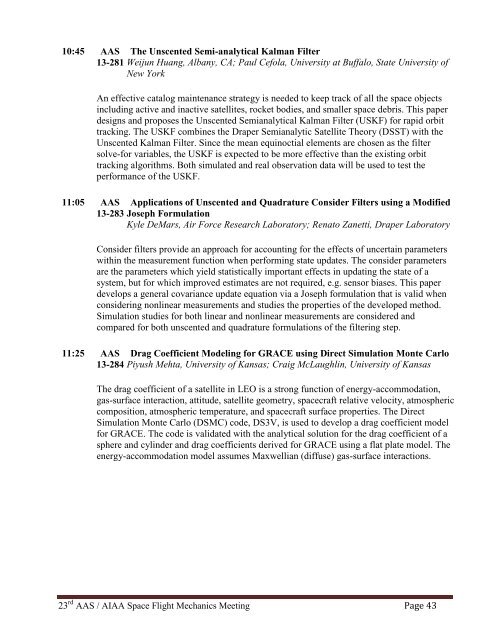meetings - Space Flight Mechanics Committee
meetings - Space Flight Mechanics Committee
meetings - Space Flight Mechanics Committee
Create successful ePaper yourself
Turn your PDF publications into a flip-book with our unique Google optimized e-Paper software.
10:45 AAS The Unscented Semi-analytical Kalman Filter<br />
13-281 Weijun Huang, Albany, CA; Paul Cefola, University at Buffalo, State University of<br />
New York<br />
An effective catalog maintenance strategy is needed to keep track of all the space objects<br />
including active and inactive satellites, rocket bodies, and smaller space debris. This paper<br />
designs and proposes the Unscented Semianalytical Kalman Filter (USKF) for rapid orbit<br />
tracking. The USKF combines the Draper Semianalytic Satellite Theory (DSST) with the<br />
Unscented Kalman Filter. Since the mean equinoctial elements are chosen as the filter<br />
solve-for variables, the USKF is expected to be more effective than the existing orbit<br />
tracking algorithms. Both simulated and real observation data will be used to test the<br />
performance of the USKF.<br />
11:05 AAS Applications of Unscented and Quadrature Consider Filters using a Modified<br />
13-283 Joseph Formulation<br />
Kyle DeMars, Air Force Research Laboratory; Renato Zanetti, Draper Laboratory<br />
Consider filters provide an approach for accounting for the effects of uncertain parameters<br />
within the measurement function when performing state updates. The consider parameters<br />
are the parameters which yield statistically important effects in updating the state of a<br />
system, but for which improved estimates are not required, e.g. sensor biases. This paper<br />
develops a general covariance update equation via a Joseph formulation that is valid when<br />
considering nonlinear measurements and studies the properties of the developed method.<br />
Simulation studies for both linear and nonlinear measurements are considered and<br />
compared for both unscented and quadrature formulations of the filtering step.<br />
11:25 AAS Drag Coefficient Modeling for GRACE using Direct Simulation Monte Carlo<br />
13-284 Piyush Mehta, University of Kansas; Craig McLaughlin, University of Kansas<br />
The drag coefficient of a satellite in LEO is a strong function of energy-accommodation,<br />
gas-surface interaction, attitude, satellite geometry, spacecraft relative velocity, atmospheric<br />
composition, atmospheric temperature, and spacecraft surface properties. The Direct<br />
Simulation Monte Carlo (DSMC) code, DS3V, is used to develop a drag coefficient model<br />
for GRACE. The code is validated with the analytical solution for the drag coefficient of a<br />
sphere and cylinder and drag coefficients derived for GRACE using a flat plate model. The<br />
energy-accommodation model assumes Maxwellian (diffuse) gas-surface interactions.<br />
23 rd AAS / AIAA <strong>Space</strong> <strong>Flight</strong> <strong>Mechanics</strong> Meeting Page 43
















